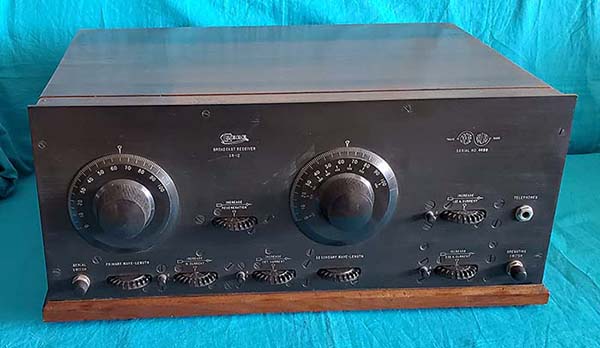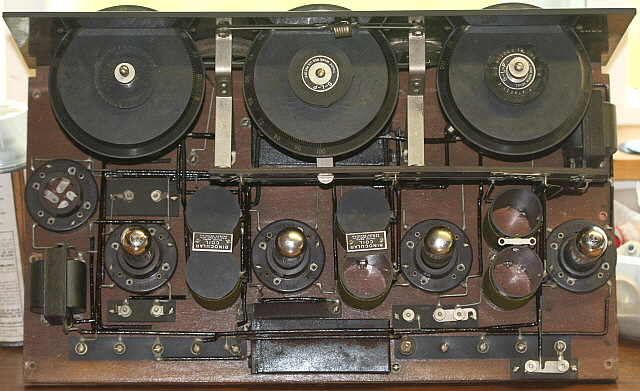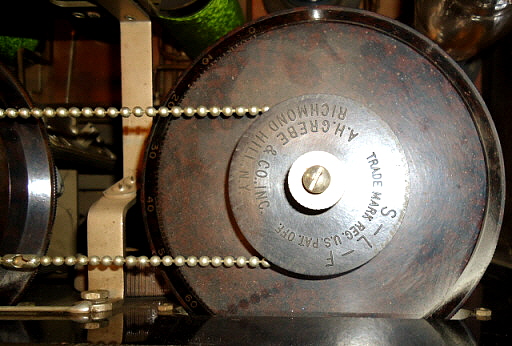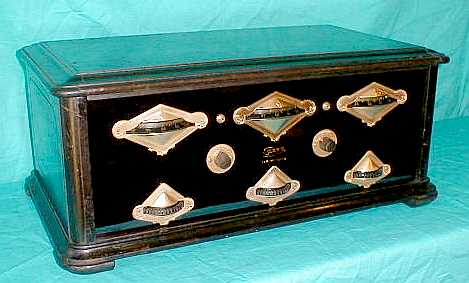|
MU-1 Early Production
Aug. 1924 to mid-1925 - No Chain Drive, no Band
Switch, four +22.5vdc B-batteries shown on hook-up card |
BLYI - (one lid prop, early type)
CCBU - (early type - no other details)
CTPB - (VOL/FIL on R.E.,with Batt. Base option, 2LPs)
FWWC - (VOL/FIL on R.E, from console model)
HVXD - (early type - Battery Base option)
JRPI - (Two FIL R.E., early type)
JTRC - (INCREASE only on Round Esc., 2 lid props)
LBCO - (VOL/FIL on R.E.)
LYWA - (INCREASE only on Round Esc., 2 lid props)
MPRI - (VOL/FIL on R.E., 2 lid props)
PNBU - (Early type, 2 lid props)
RXJA - (Early type)
STNU - (Early type)
TBRI - (Early type)
VSGB - (Early type w/4 B-batteries shown on card)
WJVX - w/ Batt. Base opt., 2 LPs)
WZJX - (Early Type)
ZDVC - (VOL/FIL on R.E., 2 lid props)
ZLXA - (Early type)
|
MU-2 Early Production
No Chain Drive or Band Switch, 6 Tubes all UV-199 |
BNDU - No Chain Drive, six UV-199 tubes
HSGC - No Chain Drive, six UV-199 tubes
VLZX - No Chain Drive, six UV-199 tubes
VYVA - No Chain Drive, six UV-199 tubes
|
|
MU-1 Intermediate
Production
mid-1925 to mid-1926 - Chain Drive, Band Switch, both xmfrs
the same size, +90VDC B+ w/two +45vdc B-batteries |
BZNW - (Long B+, C- Caps)
CSPY - (Short B+, C- Caps)
FYJH - (Short B+, C- Caps)
GLYW - (Short B+, C- Caps)
GNPX - (Short B+, C- Caps)
JBBR - (Short B+, C- Caps)
JPSO - (std. mid-production)
KKKH - (std. mid-production)
LSRY - (std. mid-production)
MFSS - (Short B+, C- Caps)
MPCY - (std. mid-production)
NZCW - (std. mid-production)
PGNY - (Short B+, C- Caps)
PPSN - (std. mid-production)
PYLP - (std.mid-production, except has all Cushion Sockets)
RJNA - (Long B+,C- Caps, has 1926 Factory Upgrades)
SRSS - (Short B+,C- Caps)
TPTN - (std. mid-production)
VZLR - (Short B+,C- Caps)
WGXD - (Long B+, C- Caps)
XFGI - (std. mid-production)
XHHP -(std. mid-production)
YKYG - (std. mid-production)
ZYLC - (std. mid-production)
ZYXG - (Short B+, C- Caps)
|
MU-2 Late Production
Chain Drive, Band Switch, 5 Tubes, both xmfrs the
same size, Cushion Sockets, +135vdc B+ |
DMJA - Chain Drive, four UV-199 and one UX-120
SKHX - Chain Drive, four UV-199 and one UX-120
WKYA - Chain Drive, four UV-199 and one UX-120
|
|
MU-1 Late Production
mid-1926 to mid-1927 - Large 1AF Xmfr, UX-112 tube, +135vdc
B+ w/three +45vdc B-batteries and Cushion-type Tube Sockets |
BPZI - (UX-112, no other details provided)
BXVD - (Late version)
CCYI - (All Cushion Sockets, S-L-F embossed)
CFFI - (UX-112, no other details provided)
CMCP - (UX-112, cushion sockets)
CRZD - (No detailed data available)
DJJU - (S-L-F embossed)
DTCM - (Late Version)
FSPG - (All Cushion Sockets, S-L-F embossed)
HLLY - (UX-112, cushion sockets)
HZFP - (UX-112, cushion sockets, red/black mottled dials)
JMMT - (All Cushion Sockets, S-L-F embossed)
JVFR - (All Cushion Sockets, S-L-F embossed)
KBZT - (All Cushion Sockets)
KVWY - (All Cushion Sockets)
LGYS - (All Cushion Sockets, S-L-F embossed)
LSHR - (All Cushion Sockets, mottled dials)
MFPA - (All Cushion Sockets, S-L-F embossed)
MHSA - (All Cushion Sockets, S-L-F embossed - Console)
MNZC - (Det Cushion Socket, S-L-F embossed)
NBLL - (All Cushion Sockets, late version)
NCSO - (Det Cushion Socket, S-L-F embossed)
NLCH - (All Cushion Sockets, S-L-F embossed)
NRFM - (All Cushion Sockets, S-L-F embossed)
NSHR - (All Cushion Sockets, S-L-F embossed)
PMMA - (All Cushion Sockets, no other data)
PVPA - (Det Cushion Socket, S-L-F embossed)
RDBD - (Det Cushion Socket, S-L-F embossed)
RGZL - (All Cush Sckts, S-L-F emb, Mottled Dials)
RPVA - (Det. Cushion Socket, S-L-R embossed)
SGDR - (All Cushion Socket, S-L-R embossed)
SLZR - (All Cushion Sockets, S-L-F embossed)
TNZS - (Det Cushion Socket, S-L-F Metal Rings)
TPBO - (Det Cushion Socket)
VCGY - (Bayonet Sockets, S-L-F Metal Rings)
VNDX - (UX-112, large 1AF xmfr)
VVGH - (Det Cushion Socket, Older style Clutch Caps)
WGGN - (no details provided)
XBLW - (All Cushion Sockets, S-L-F emb'd, red/black mottled dials
)
XCPT - (All Cushion Sockets, S-L-F embossed)
XNYB - (Det Cushion Socket, large 1AF xmfr)
XPDP - (post 8-26)
XVRN - (Cushion Sockets, large 1AF xmfr)
YFTI - (All Cushion Sockets, S-L-F embossed)
YPND - (post 8-26)
ZRDT - (Det Cushion Socket, S-L-F embossed)
ZXZL - (All Cushion Sockets, S-L-F embossed) |


















































